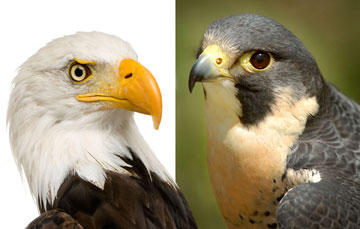Without the 1972 ban on DDT and ensuing protections, the bald eagle (left) and peregrine falcon (right), let alone dozens of other bird species, would likely be gone now in the continental U.S. Photo Cred: iStockPhoto
EarthTalk®
E – The Environmental Magazine
Dear EarthTalk: I understand there is good news about the recovery of bird species like the Peregrine Falcon, Bald Eagle and others owed to the 1972 ban on DDT. Can you explain?
— Mildred Eastover, Bath, ME
Rachel Carson’s seminal 1962 book, Silent Spring, told the real-life story of how bird populations across the country were suffering as a result of the widespread application of the synthetic pesticide DDT (dichlorodiphenyltrichloroethane), which was being used widely to control mosquitoes and others insects. Carson reported that birds ingesting DDT tended to lay thin-shelled eggs which would in turn break prematurely in the nest, resulting in marked population declines. The problem drove bald eagles, our national symbol, not to mention peregrine falcons and other bird populations, to the brink of extinction, with populations plummeting more than 80 percent.
Luckily for the birds, Silent Spring caused a stir, and many credit it with launching the modern environmental movement. Indeed, one of the world’s leading environmental non-profits, the Environmental Defense Fund (EDF), initially formed in 1967 in reaction to the DDT problem. The group’s first order of business included filing lawsuits in New York, Michigan, Wisconsin and Washington DC to force a ban on DDT. EDF enlisted the help of dozens of scientific experts—ornithologists, ecologists, toxicologists, carcinogenesis experts, and insect control specialists—to testify at multi-month hearings to prove its point in regard to the dangers of DDT. In 1972 environmentalists’ prayers were answered—and their hard work vindicated—with the federal government finally banning DDT.
But with lots of the pesticide already dispersed through ecosystems far and wide, not to mention myriad other threats to bird habitats and the environment in general, no one could be sure whether populations of eagles, falcons and other predatory and fish-eating birds would come back from the brink. While the federal Endangered Species Act went a long way to protect these at-risk species and some of their habitat, non-profits also played a key role in helping specific species recover. To wit, the Peregrine Fund was founded in 1970 by a leading Cornell ornithologist to help nurse peregrine falcon populations hit hard by DDT back to their once abundant numbers. Researchers with the group pioneered methods of breeding peregrines in captivity and releasing them into the wild; such techniques have since been adopted widely by biologists trying to bring other wildlife species back from the brink of extinction. Thanks to a combination of factors and the hard work of bird lovers and scientists, peregrine falcons are once again common across the U.S., graduating off the national endangered species list as of 1999.
The bald eagle’s recovery is perhaps the best known example of how our environmental laws worked to restore not just a resource but our very national symbol. In the mid-1960s fewer than 500 nesting pairs of bald eagles existed in the continental U.S.; today, thanks to the DDT ban and other conservation efforts, some 10,000 pairs of bald eagles inhabit the Lower 48—that’s a 20-fold population increase in just four decades! In 2007 the federal government removed the bald eagle from the Endangered Species List. Without the 1972 ban on DDT and ensuing protections, the bald eagle, let alone dozens of other bird species, would likely be gone now in the continental U.S. And without the song of the birds, the spring would be a very silent time indeed.
CONTACTS: EDF, www.edf.org; Peregrine Fund, www.peregrinefund.org.
EarthTalk® is written and edited by Roddy Scheer and Doug Moss and is a registered trademark of E – The Environmental Magazine (www.emagazine.com). Send questions to: [email protected]. Subscribe: www.emagazine.com/subscribe. Free Trial Issue: www.emagazine.com/trial.








